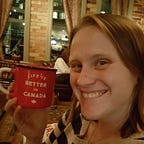What I saw at a children’s cancer ward in Tanzania
In Dar es Salaam, I learned that all parents, no matter where they are, are eager for more information about their child’s health.
When I found out I was coming to TEDGlobal 2017 in Arusha, I looked to see if there was anywhere in Tanzania where children with cancer were treated. There’s a small section of the Muhimbili National Hospital in Dar es Salaam specially kitted out as a children’s cancer ward, called Their Lives Matter (TLM). I currently work as a pediatric cancer research scientist at The Hospital for Sick Children (SickKids) in Toronto, Canada, so was hoping to learn more about the department in Tanzania and see if there was any scope for us to work together on anything from idea generation to formal collaborations.
I found out that the lead physician at TLM — an Irish pediatric oncologist, Dr Trish Scanlan—has been working in Tanzania since she visited in 2006 as part of her master’s degree and saw how desperately children with cancer in Tanzania needed better care. Though she would be away when I was there, she invited me to come and visit and speak with her medical team and meet patients and families on the ward.
I wasn’t sure what to expect, but when I arrived at the hospital in Dar Es Salaam, what immediately struck me was how incredibly busy it was. People were streaming in from the surrounding streets, and a small marketplace outside sold meals and water to people visiting the hospital.
At the children’s oncology department, the doctors, nurses and administrative team welcomed me warmly and gave me a tour of the ward, where I met patients and parents. The ward is basic in comparison to Western wards, and overcrowded due to the sheer number of patients they must admit, but there are many staff. It was clean, colorful, and equipped with a playroom, a classroom and a separate hostel that houses parents children and their parents when their conditions are more stabilized.
The team of doctors invited me on their rounds, and I learned about individual patients and their prognosis, how treatment protocols there differ from ours in the West and their most recent successes. The doctors also talked about things that troubled them. For example, their leukemia patients generally have quite a good response rate to treatment — but the children often relapse after being sent home with medications. I asked if there was a lack of compliance with taking the medications, but the doctors couldn’t conclusively say whether this was the case.
In the afternoon, I met with families with the help of a volunteer translator. I met with parents in the ward, as they couldn’t leave their children’s side, and some in the playroom, which must have had up to 40 adults and kids in there. I visited the classroom to meet the teachers and children, who tried to teach me a bit of Swahili!
In each, I briefly introduced myself as a survivor and research scientist, and I invited them to ask me anything about cancer, and I would try my best to answer. The questions varied from “Why is cancer different to tuberculosis?” to “What is cancer?” They asked why certain families had multiple members with cancer, as well as conditions such as albinism. I found myself trying to explain about cells and basic genetics. I explained that the likelihood of getting cancer could, like eye color, could be passed down from parents to offspring — but that in most cases of childhood cancer, we don’t really know what causes it yet, though it was highly unlikely to be anything they had done.
One parent asked why the children still needed to take drugs once they got home. I explained that although the cancer appeared cured, it was possible small, invisible amounts were left. I used the metaphor of a plant being harvested, but leaving behind roots and seeds under the soil, from which a whole new plant can grow if not properly removed.
The parents started conversing amongst themselves. After a while, my interpreter told me that they wanted to make a booklet of questions to give to new parents in the hospital, so everyone could have the same information that they’d learned here. I said I’d would be more than happy to help, if they could collect the questions they wanted and give them to the translator, who would then email me with the list. I plan to work with the staff at the hospital to develop this in an accessible and informative way — largely using pictures (some of the parents are illiterate) and some Swahili when necessary.
I’ll also continue to help the doctors and staff that I met with advice and guidance for any research projects they might want to do, and put them in touch with a colleague who coordinates a UK-Malawi children’s cancer partnership, as the team seemed incredibly interested in her research. Hopefully they’ll be able to work together to expand the program to Tanzania.
Despite considerable differences in the backgrounds of parents of children with cancer in Tanzania and other places I’ve worked, such as the UK and Canada, one thing is clear: they share incredible similarities. Besides the obvious hope and determination that their children will recover, all parents who have children with cancer are driven to learn as much as they can about why their child is sick. The difference is that knowledge isn’t as easily accessible in Tanzania as in many other places in the world.
I hope to continue working with the hospital and their amazing staff to address this, so that, at an already very stressful and confusing time, no parent is left with unanswered questions about what is happening to their child.
The TED Fellows program hand-picks young innovators from around the world to raise international awareness of their work and maximize their impact.
